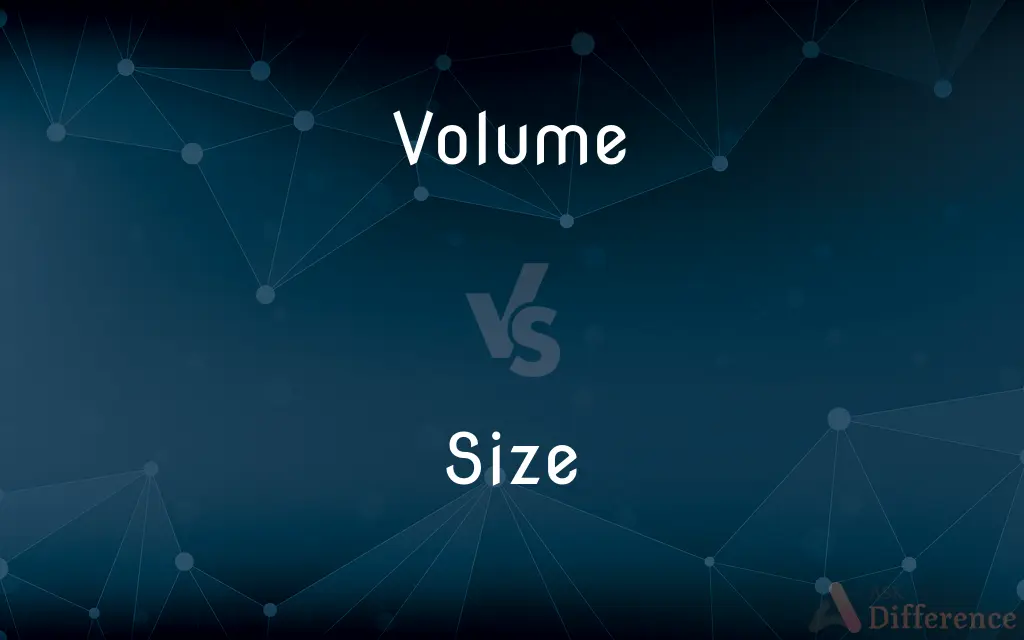Volume vs. Size — What's the Difference?
By Fiza Rafique & Urooj Arif — Updated on March 1, 2024
Volume measures the space an object occupies, while size refers to its dimensions.

Difference Between Volume and Size
Table of Contents
ADVERTISEMENT
Key Differences
Volume is a specific measurement that quantifies the amount of space an object occupies, typically in three-dimensional space. It is measured in cubic units, such as cubic meters or liters, and is crucial in determining the capacity of containers or the space that an object can fill. Whereas size is a more general term that refers to the dimensions or magnitude of an object, which can be expressed in terms of length, width, height, or even in abstract terms like small, medium, and large.
Volume is a critical measurement in fields such as chemistry, cooking, and manufacturing, where knowing the exact space a substance or item occupies is necessary for processes like mixing, storage, and packaging. On the other hand, size is often used in everyday contexts to describe objects, clothing, or other items where precise measurements are not as critical, and a general understanding of dimensions is sufficient.
While volume is strictly used to measure three-dimensional spaces and is always a numerical value, size can describe both two-dimensional and three-dimensional objects and can be qualitative or quantitative. This distinction highlights how volume is specifically focused on capacity and space occupation, whereas size provides a broader understanding of an object's overall dimensions.
Volume measurements are indispensable for tasks requiring precision, such as calculating shipping costs based on the space a package occupies, or determining the amount of liquid a bottle can hold. Size, however, is more versatile and can be applied to a wider range of scenarios, from selecting clothing that fits to choosing furniture that will fit in a room.
While both volume and size describe aspects of an object's physical properties, their applications and the precision of the information they convey differ significantly. Volume provides a precise measurement of space occupied, essential for scientific and practical applications, while size offers a more general perspective on an object's dimensions, useful for everyday decisions and descriptions.
ADVERTISEMENT
Comparison Chart
Measurement Type
Three-dimensional space occupation
General dimensions or magnitude
Units
Cubic meters, liters, cubic centimeters
Inches, meters, qualitative descriptions
Applications
Chemistry, cooking, manufacturing
Clothing, furniture, general descriptions
Precision
High, numerical values
Can be qualitative or quantitative
Focus
Capacity and space occupation
Overall dimensions and fit
Compare with Definitions
Volume
The space gas occupies, often variable with pressure and temperature.
The balloon's volume increases as it is heated.
Size
The number of individuals in a population.
The size of the city's population is 300,000.
Volume
The space a solid object occupies.
The cube's volume was calculated to be 27 cubic centimeters.
Size
The amount of digital data in a file.
The file size of the image is 5 megabytes.
Volume
The amount of a financial instrument traded over a time period.
The stock had a trading volume of 1 million shares today.
Size
The dimensions of an object.
The size of the table is 6 feet by 4 feet.
Volume
The perceived loudness of a sound.
He turned up the volume on the stereo.
Size
A standard measurement for clothing.
She wears a size medium in shirts.
Volume
Volume is the quantity of three-dimensional space enclosed by a closed surface, for example, the space that a substance (solid, liquid, gas, or plasma) or 3D shape occupies or contains. Volume is often quantified numerically using the SI derived unit, the cubic metre.
Size
The magnitude or extent of a celestial object.
The size of the planet is twice that of Earth.
Volume
The amount of space a liquid occupies.
The bottle has a volume of 2 liters.
Size
Size in general is the magnitude or dimensions of a thing. More specifically, geometrical size (or spatial size) can refer to linear dimensions (length, width, height, diameter, perimeter), area, or volume.
Volume
A collection of written or printed sheets bound together; a book.
Volume
One of the books of a work printed and bound in more than one book.
Volume
A series of issues of a periodical, usually covering one calendar year.
Volume
A unit of written material assembled together and cataloged in a library.
Volume
Hence, a collection of printed sheets bound together, whether containing a single work, or a part of a work, or more than one work; a book; a tome; especially, that part of an extended work which is bound up together in one cover; as, a work in four volumes.
An odd volume of a set of books bears not the value of its proportion to the set.
Volume
A publication that is one of a set of several similar publications;
The third volume was missing
He asked for the 1989 volume of the Annual Review
Volume
A relative amount;
Mix one volume of the solution with ten volumes of water
Volume
The magnitude of sound (usually in a specified direction);
The kids played their music at full volume
Common Curiosities
How do manufacturers use volume measurements?
Manufacturers use volume to design packaging and determine how much product can fit inside containers.
Can the volume of solid objects change?
Typically, the volume of solid objects remains constant unless the object is deformed or changed in state.
How does temperature affect the volume of gases?
The volume of gases expands with an increase in temperature and contracts with a decrease.
What is the significance of file size in computing?
File size affects storage and transfer times, influencing how data is managed and accessed.
What determines an object's volume?
An object's volume is determined by the amount of three-dimensional space it occupies.
Why is volume important in cooking?
Volume measurements are crucial for accurately measuring ingredients, which affects the outcome of recipes.
Is file size considered a type of volume?
No, file size refers to the amount of data and is a concept distinct from the physical volume.
How is volume measured in different contexts?
Volume can be measured in liters for liquids, cubic meters for larger spaces, and cubic centimeters for solids.
Can size be subjective?
Yes, size can be subjective, especially when described qualitatively (e.g., large, small).
What role does size play in fashion?
Size determines the fit of clothing and is essential for ensuring comfort and style.
Why is understanding population size important?
It helps in planning resources, infrastructure, and services for communities.
How does pressure affect gas volume?
Increasing pressure decreases gas volume, and decreasing pressure increases it, following Boyle's law.
How do astronomers determine the size of celestial objects?
Through observations and calculations based on light and movements, providing insights into their magnitude.
Can the size of an object affect its volume?
Yes, larger objects typically have a greater volume, as they occupy more space.
What is the difference between volume and capacity?
Volume is the space an object occupies, while capacity refers to the volume that a container can hold.
Share Your Discovery

Previous Comparison
Decide vs. Determine
Next Comparison
Discrepancy vs. DifferenceAuthor Spotlight
Written by
Fiza RafiqueFiza Rafique is a skilled content writer at AskDifference.com, where she meticulously refines and enhances written pieces. Drawing from her vast editorial expertise, Fiza ensures clarity, accuracy, and precision in every article. Passionate about language, she continually seeks to elevate the quality of content for readers worldwide.
Co-written by
Urooj ArifUrooj is a skilled content writer at Ask Difference, known for her exceptional ability to simplify complex topics into engaging and informative content. With a passion for research and a flair for clear, concise writing, she consistently delivers articles that resonate with our diverse audience.















































